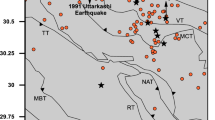Abstract
A method is presented for deriving 1-D velocity depth models from earthquake bulletin data. The models can be used as initial models for more advanced modelling techniques such as tomographic inversion. The method is useful when there is little or no refraction and long-range reflection survey data. The bulletin travel times are subjected to an analysis of variance, where they are separated into source, distance, and receiving station terms. The distance terms describe the variation of travel time with distance, and the associated trend lines allow 1-D velocity models for the crustal layers to be determined. The velocity models provide an average crustal model for the region derived from local data. This does not include superficial layers which are necessarily poorly determined. Earthquake bulletin P-wave data from propagation paths across three different regions of the UK are employed to illustrate the use of the technique.
Similar content being viewed by others
References
Barton PJ (1992) LISPB revisited: a new look under the Caledonides of Northern Britain. Geophys J Int 110:371–391. doi:10.1111/j.1365-246X.1992.tb00881.x
Bamford D, Nunn K, Prodehl C, Jacob B (1978) LISPB-IV. Crustal structure of northern Britain. Geophys J R Astron Soc 54:43–60
Bott MHP, Long RE, Green ASP, Lewis AHJ, Sinha MC, Stevenson DL (1985) Crustal structure south of the Iapetus Suture beneath northern England. Nature 314:724–727. doi:10.1038/314724a0
Brownlee KA (1965) Statistical theory and methodology in science and engineering, 2nd edn. Wiley, New York
Carpenter EW, Marshall PD, Douglas A (1967) The amplitude–distance curve for short period teleseismic P-waves. Geophys J R Astron Soc 13:61–70
Chadwick RA, Pharaoh TC (1998) The seismic reflection Moho beneath the United Kingdom and adjacent areas. Tectonophys 299:255–279. doi:10.1016/S0040-1951(98)00193-0
Clegg B, England RW (2003) Velocity structure of the UK continental shelf from a compilation of wide-angle and refraction data. Geol Mag 140:453–467. doi:10.1017/S0016756803007866
Fisher RA (1925) Statistical methods for research workers. Hafner, New York
Hall J, Powell DW, Warner MR, El-Isa ZH, Adesanya O, Bluck BJ (1983) Seismological evidence for shallow crystalline basement in the Southern Uplands of Scotland. Nature 305:418–420. doi:10.1038/305418a0
Havskov J, Bungum H (1987) Source parameters for earthquakes in the North Sea. Nor Geol Tidsskr 67:51–58
Galloway DD (ed.) (2008) Bulletin of British earthquakes 2007. British Geological Survey Technical Report OR/08/048
Jacob AWB (1969) Crustal phase velocities observed at the Eskdalemuir seismic array. Geophys J R Astron Soc 18:189–197
Kearey P, Brooks M (1984) An introduction to geophysical exploration. Blackwell, Oxford
Kelly A, England RW, Maguire PKH (2007) A crustal seismic velocity model for the UK, Ireland and surrounding seas. Geophys J Int 171:1172–1184
Kempthorne O (1952) Design of experiments. Wiley, New York
Kissling E (1988) Geotomography with local earthquake data. Rev Geophys 26:659–698
Kissling E, Ellsworth WL, Eberhart-Phillips D, Kradolfer U (1994) Initial reference models in local earthquake tomography. J Geophys Res 99:19635–19646
Lee W, Lahr J (1975) HYPO71 (revised). A computer program for determining hypocenter, magnitude and first motion pattern of local earthquakes. Open File Rep US Geol Surv 75
Scheffé H (1959) The analysis of variance. Wiley, London
Thurber CH (1983) Earthquake locations and three-dimensional crustal structure in the Coyote Late area, central California. J Geophys Res 88:8226–8236
Thurber CH (1987) Analysis methods of kinematic data from local earthquakes. Rev Geophys 24:793–805
Tomlinson JP, Denton P, Maguire PKH, Booth DC (2006) Analysis of the crustal structure of the British Isles using teleseismic receiver functions. Geophys J Int 167:223–237
Whitcombe DN, Maguire PKH (1980) An analysis of velocity structure of the Precambrian rocks of Charnwood Forest. Geophys J R Astron Soc 63:405–416
Author information
Authors and Affiliations
Corresponding author
Rights and permissions
About this article
Cite this article
Booth, D.C. UK 1-D regional velocity models by analysis of variance of P-wave travel times from local earthquakes. J Seismol 14, 197–207 (2010). https://doi.org/10.1007/s10950-009-9160-4
Received:
Accepted:
Published:
Issue Date:
DOI: https://doi.org/10.1007/s10950-009-9160-4




